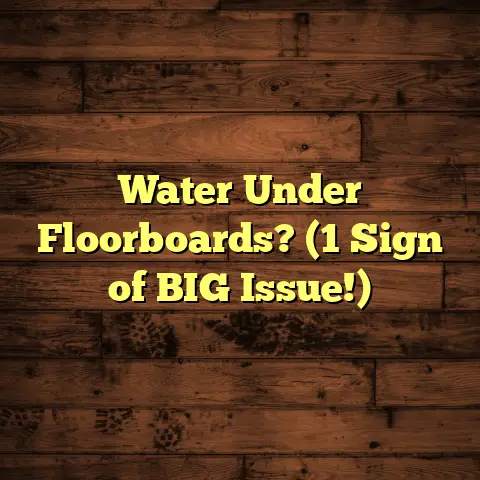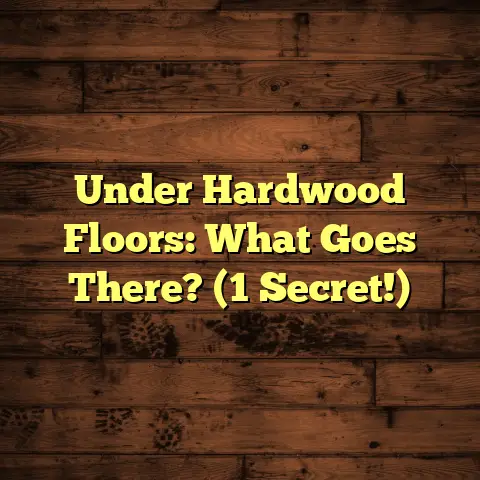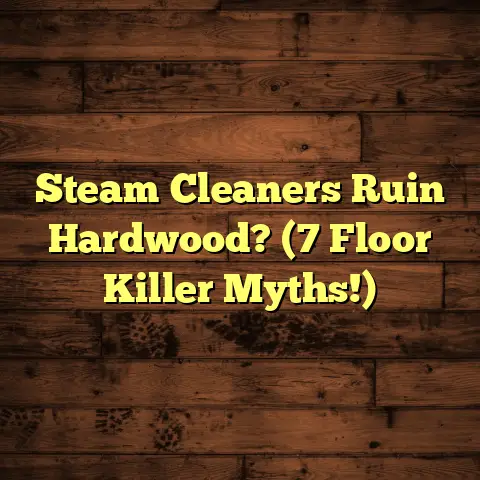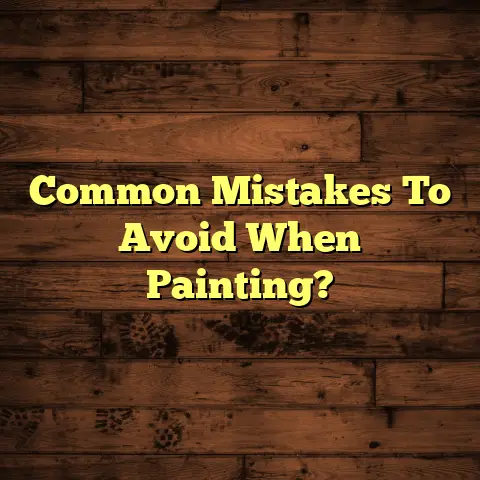Clorox To Clean Floors? (9 Pro Warnings!)
Ah, the changing seasons!
Spring cleaning, summer maintenance,
fall prep, and winter deep cleaning.
It’s like our homes
have their own little calendars, right?
As a flooring contractor with years under my belt, I see firsthand how these seasonal shifts influence how we care for our floors.
Think about it: spring brings the urge to declutter and
scrub away the winter blues.
Summer?
It’s all about
keeping things fresh and sand-free after beach trips.
Then comes fall, prepping for cozy gatherings and
holiday feasts.
And winter?
Well, that’s when we
really dig in for a deep clean to combat mud and
snow tracked inside.
A clean floor sets the stage for a welcoming home,
especially when you’re hosting family and friends.
And let’s be honest, a little sparkle can lift everyone’s
spirits, right?
Now, many homeowners reach for Clorox, that iconic bleach-based cleaner, to tackle floor hygiene, especially during these busy times.
It’s powerful, readily available, and promises to
eliminate germs and stains.
But here’s the thing:
using Clorox on floors isn’t always a slam-dunk.
It’s crucial to understand how to use it properly on different flooring types to avoid potential damage or unintended consequences.
Trust me, I’ve seen it all – from faded hardwood to
discolored tile.
So, let’s dive in and get the lowdown
on using Clorox on your floors!
Section 1: The Popularity of Clorox for Floor Cleaning
Why is Clorox such a go-to for floor cleaning?
Well, for starters, it’s a powerhouse when it comes to
killing germs and bacteria.
In our germ-conscious world,
that’s a major selling point.
It’s also pretty effective at removing stains, from
stubborn spills to ground-in grime.
Plus, it’s
versatile – many people use it on tile, laminate, vinyl,
and even to spot-clean carpets.
According to a 2023 survey by Statista, Clorox is
one of the leading household cleaning brands in the
United States, with a brand recognition rate of over 90%.
That’s huge!
A big part of Clorox’s popularity comes down to its
brand reputation.
For generations, it’s been synonymous
with cleanliness and disinfection.
This is especially true during health crises and flu
seasons when people are extra vigilant about sanitizing
their homes.
When you see that familiar bottle, you
automatically think “clean,” right?
But don’t let that brand recognition lull you into a
false sense of security.
Just because it’s popular
doesn’t mean it’s always the best or safest choice
for your floors.
Section 2: Understanding Different Floor Types
Okay, let’s talk flooring.
Every floor is different,
and what works for one might be a disaster for another.
As a flooring contractor, I can’t stress this enough.
Hardwood: Think classic beauty and warmth.
- Characteristics: Natural wood, can be solid or engineered.
- Common Issues: Scratches, water damage, fading, warping.
- General Cleaning: Gentle cleaners, avoid excess water, regular sweeping/vacuuming.
Laminate: A budget-friendly alternative to hardwood.
- Characteristics: Synthetic material designed to mimic wood or tile.
- Common Issues: Scratches, swelling from moisture, peeling.
- General Cleaning: Damp mopping, avoid excess water, specialized laminate cleaners.
Tile: Durable and great for high-traffic areas.
- Characteristics: Ceramic, porcelain, or stone.
- Common Issues: Grout stains, cracks, chips.
- General Cleaning: Regular mopping with appropriate cleaner, grout cleaning as needed.
Vinyl: Versatile and water-resistant.
- Characteristics: Synthetic material available in sheets, tiles, or planks.
- Common Issues: Scratches, dents, discoloration.
- General Cleaning: Damp mopping, avoid abrasive cleaners, vinyl-specific cleaners.
Carpets: Adds comfort and warmth to a room.
- Characteristics: Variety of fibers (nylon, polyester, wool, etc.).
- Common Issues: Stains, odors, wear and tear.
- General Cleaning: Regular vacuuming, professional cleaning, spot treatment for stains.
Each of these flooring types reacts differently to cleaning products, including Clorox.
Hardwood and laminate are particularly sensitive to water and harsh chemicals, while tile and vinyl are more resilient but can still be damaged by improper use of Clorox.
Carpets, of course, require specialized cleaning methods and are generally not suitable for Clorox unless for very specific spot treatments.
Section 3: The Benefits of Using Clorox on Floors
Let’s not throw the baby out with the bathwater.
Clorox does have some benefits when it comes to
floor cleaning:
- Disinfecting: Clorox is a powerful disinfectant that can kill a wide range of germs and bacteria, making it ideal for bathrooms, kitchens, and other areas prone to microbial growth.
- Stain Removal: It can be effective at removing tough stains, such as mildew, mold, and food spills.
- Ease of Use: Clorox is readily available at most grocery stores and is easy to use – just dilute it with water and apply to the floor.
- Quick Drying Time: When properly diluted and applied, Clorox solutions tend to dry quickly, reducing the risk of slips and falls.
- Cost-Effectiveness: Compared to professional cleaning services or specialized cleaning products, Clorox can be a relatively inexpensive option.
However, remember that these benefits come with a
caveat: you must use Clorox correctly.
Otherwise,
you could end up causing more harm than good.
Section 4: The 9 Pro Warnings About Using Clorox on Floors
Alright, here’s the meat of the matter.
As a seasoned
flooring contractor, I’ve seen the damage that can
result from improper Clorox use.
These are the nine
critical warnings you need to know:
1. Dilution Matters
This is HUGE.
Never, ever use Clorox full strength on
your floors.
Always dilute it with water according to
the manufacturer’s instructions.
The recommended dilution ratio is typically 1/2 cup of Clorox per gallon of water, but always check the label on your specific Clorox product.
Using too much Clorox can damage the finish on hardwood and laminate floors, leading to discoloration, streaking, and even permanent damage.
It can also leave a sticky residue that attracts dirt
and grime.
Think of it like over-soaping your laundry –
you end up with a mess!
2. Surface Compatibility
Not all floors are created equal, and Clorox is not safe for all surfaces.
Avoid using Clorox on:
- Unsealed Hardwood: The bleach can penetrate the wood and cause irreversible damage.
- Natural Stone: Marble, granite, and other natural stones can be etched and discolored by Clorox.
- Certain Types of Laminate: Some laminates
are more sensitive to bleach than others.
Always test in an inconspicuous area first. - Carpet (Generally): While you can use a very diluted solution for spot treatments, it’s risky and can cause discoloration.
Clorox is generally safe for use on glazed tile and most vinyl floors, but again, always test in a hidden area first to be sure.
3. Color Bleeding
This is a big one, especially if you have colored or
patterned floors.
Clorox is a bleaching agent, and it
can strip the color from certain materials.
I’ve seen beautiful tile floors with intricate designs
completely ruined by improper Clorox use.
The colors
fade, the patterns disappear, and you’re left with a
blotchy, uneven mess.
Be especially careful with:
- Colored Grout: Grout is porous and can easily absorb bleach, leading to discoloration.
- Printed Vinyl: The printed patterns on some vinyl floors can fade or disappear when exposed to Clorox.
- Dyed Carpets: Clorox can cause permanent discoloration and fading.
4. Fumes and Ventilation
Clorox has a strong odor, and those fumes can be
irritating to your eyes, nose, and throat.
In some
cases, they can even trigger asthma attacks or other
respiratory problems.
Always ensure adequate ventilation when using Clorox.
Open windows and doors to allow fresh air to circulate.
If you’re particularly sensitive to fumes, consider
wearing a mask.
I always advise my clients to err on the side of
caution when it comes to ventilation.
It’s better to
be safe than sorry!
5. Mixing with Other Cleaners
This is a major no-no.
Never, ever mix Clorox with
other cleaning agents, especially ammonia or acidic
cleaners.
Mixing Clorox with ammonia can create toxic chloramine
gas, which can cause serious respiratory problems and
even death.
Mixing Clorox with acidic cleaners can
release chlorine gas, which is also highly toxic.
I know it might be tempting to combine cleaners for
“extra” cleaning power, but trust me, it’s not worth
the risk.
Stick to using Clorox on its own, diluted
with water.
6. Residue Build-Up
If you don’t rinse your floors properly after cleaning with Clorox, you can end up with a sticky residue that attracts dirt and grime.
This residue can also dull the finish on your floors and make them look dingy over time.
After mopping with a Clorox solution, always rinse
your floors with clean water.
You may need to rinse
them several times to remove all traces of the cleaner.
7. Long-Term Effects
Even if you use Clorox correctly, frequent use can still degrade certain flooring materials over time.
The harsh chemicals in Clorox can weaken the finish on hardwood and laminate floors, making them more susceptible to scratches and damage.
It can also cause grout to crumble and discolor.
I recommend using Clorox sparingly and opting for gentler cleaning solutions for regular maintenance.
8. Children and Pets Safety
Clorox is toxic if ingested, and it can also irritate
the skin and eyes.
Keep children and pets away from
areas that have been cleaned with Clorox until they
are completely dry.
Store Clorox out of reach of children and pets.
If a child or pet ingests Clorox, contact a poison control center or seek medical attention immediately.
9. Environmental Concerns
Clorox is a harsh chemical that can have a negative
impact on the environment.
When you pour Clorox down
the drain, it can contaminate waterways and harm aquatic
life.
Consider using more environmentally friendly cleaning
solutions whenever possible.
There are many effective
alternatives to Clorox that are safer for the planet.
Section 5: Alternatives to Clorox for Floor Cleaning
Okay, so Clorox has its drawbacks. What are some safer, more environmentally friendly alternatives?
- Vinegar and Water: A simple solution of
vinegar and water can be surprisingly effective
at cleaning floors.
It’s safe for most surfaces (except natural stone) and leaves a fresh, clean scent. - Baking Soda: Baking soda is a gentle abrasive
that can be used to scrub away stains and grime.
Mix it with water to form a paste and apply to the affected area. - Hydrogen Peroxide: Hydrogen peroxide is a
natural disinfectant that can be used to kill
germs and bacteria.
It’s also effective at removing stains. - Commercial Green Cleaners: There are many
commercial cleaning products that are made with
natural, plant-based ingredients.
Look for products that are labeled as “eco-friendly” or “biodegradable.”
I often recommend my clients try these alternatives first, reserving Clorox for those truly tough cleaning situations.
Conclusion
So, there you have it – the pros and cons of using
Clorox on your floors.
It’s a powerful cleaner that
can be effective at disinfecting and removing stains,
but it’s also important to be aware of the potential
risks.
Remember, proper dilution, surface compatibility, ventilation, and rinsing are key to avoiding damage and ensuring the safety of your family and pets.
And don’t forget to consider the environmental impact of using bleach products.
Ultimately, the decision of whether or not to use
Clorox on your floors is up to you.
But I hope this
article has given you the information you need to make
an informed choice.
By taking these steps, you can maintain your floors safely, ensuring your home remains clean, welcoming, and healthy throughout the year.
Call to Action
Now, I’d love to hear from you!
Have you had any
experiences with using Clorox or alternative methods
for cleaning floors?
Share your thoughts and tips in the comments section
below.
How do seasonal changes affect your cleaning
routines, and what measures do you take to protect
your flooring investments?





